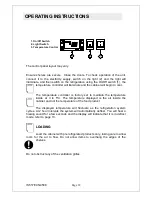
IS517 ECN4508
Page 16
Troubleshooting
Problem
Possible Cause
Solution
Compressor will not start
No voltage in socket
Use voltmeter to check
Electrical conductor or wires may be
cut
Use ohmmeter to check for continuity
Defective electrical component:
controller, relay, thermal protector etc
Replace defective component
Compressor motor has a winding
open or shorted
Measure ohmic resistance of main
and auxiliary winding using
ohmmeter. Compare with correct
values
Change compressor
Compressor stuck
Change compressor
Temperature control contacts are
open
Replace the controller
Incorrect wiring
Check wiring diagram and correct
Fuse blown or circuit breaker tripped.
Replace fuse or reset circuit breaker
Mains Power cable unplugged
Plug in main power cable
Controller set too high
Set controller to lower temperature.
Cabinet in defrost cycle
Wait for defrost cycle to finish
The temperature is too cold
Controller is set at a very cold
position
Set to factory parameter and check if
the compressor stops according to
controllers operating range.
Controller does not disconnect the
condensing unit
Check the insulation of the controller
and probe(s). If problem persists,
change the controller and probe
Control contacts are stuck closed
Change the control. Check amperage
load
Defective or incorrect temperature
controller
Determine correct controller and
replace.
The temperature is not cold
enough
Controller is set at a very warm
position
Set to factory parameter and check if
the compressor stops according to
controllers operating range
Condenser is dirty
Clean condenser
The refrigerator has been placed at
an inadequate location
The unit must not be near stoves,
walls that are exposed to the sun, or
places that lack sufficient air flow.
Compressor is inefficient or there is a
high pressure due to the air in the
system
If there is air in the system, purge and
recharge
Iced up evaporator coil
Check temperature control,
refrigerant charge, and defrost
mechanism. Remove all ice manually
and start over.
Too many door openings
Advise user to decrease if possible
Excessive heat load placed in cabinet
Advise user not to put in products that
are too hot.
Excessive heat load placed in cabinet
Advise user not to put in products that
are too hot.
The refrigerator has been
overcharged with the refrigerant gas
Check to see if condensation or ice
crystals have formed on the suction
line. If so, charge with the correct
amount of gas.























